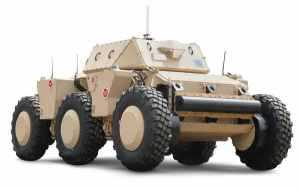Articles >>
US Army Testing Rugged, Autonomous Robot Vehicle
Category: Robots

Arlington, Va. -- The U.S. Army's Autonomous Platform Demonstrator, or APD, is a 9.6-ton, six-wheeled, hybrid-electric robotic vehicle currently undergoing developmental and mobility testing at Aberdeen Proving Ground, Md.; the demonstrator vehicle represents the state of the art in unmanned ground vehicle mobility technology. With its advanced hybrid-electric drive train, the 15-foot-long vehicle, being developed by the U.S. Army Tank Automotive Research, Development and Engineering Center, or TARDEC, can achieve speeds of over 50mph. When equipped with its autonomous navigation system, the APD is configured with GPS waypoint technology, an inertial measurement unit and computer algorithms which enable it to move autonomously at speeds up to 50mph while avoiding obstacles in its path. "The vehicle has obstacle detection and avoidance technology," said Dr. Jim Overholt, senior research scientist in robotics, Tank Automotive Research, Development and Engineering Center. The mobility testing is aimed at advancing and developing the robot's ability to maneuver at higher speeds while maintaining extreme terrain-ability at lower speeds. "We've run it through courses, slope testing and brake testing," said Chris Ostrowski, associate director for Vehicle Electronics and Architectures at TARDEC. The APD is currently testing high-speed maneuverability, such as lane changing. "This is a challenging controls problem with a skid steer vehicle. We want the robot to be stable when performing maneuvers like this, but we also want it to retain the other mobility characteristics that it possesses at lower speeds," said Ostrowski. Other mobility characteristics include the ability to climb a one-meter step, navigate a 60-percent slope, and pivot turn in place. Being a series hybrid-electric vehicle, the APD is propelled by six in-hub electric motors and has a diesel generator which charges its lithium ion batteries. "The state-of-the-art hybrid-electric drive train is just one of the mobility technologies we are demonstrating with this platform," said Andrew Kerbrat, APD project manager, TARDEC. Other technologies being demonstrated include advanced suspension systems, thermal and power management systems, robotic safety systems, and lightweight hull technologies. "We've made a lot of progress with this platform in a short time period. From concept to wheels on the ground was just a shade over two years, and in the eight months since then, we've driven almost 3,000 kilometers and have demonstrated 95 percent of the metrics that we were trying to show with this platform," said Kerbrat. APD is the mobility platform being used by the Robotic Vehicle Control Architecture, or RVCA Army Technology Objective, also out of TARDEC. Working with PEO-Integration, RVCA has integrated a suite of system control, display and sensing hardware and software onto APD that allow it to be controlled real-time by a Soldier, or operate in an autonomous mode. "It uses a variety of sensors and a Ladar -- a laser/radar scanning radar that can detect moving objects at distances," said Overholt. Additionally, RVCA provides Reconnaissance Surveillance and Target Acquisition capabilities. "It has a four-meter mast with a sensor ball on top so it goes up pretty high and can see out quite a ways," said Chris Ostrowski. "When you combine the autonomy and control capabilities provided by RVCA with the extreme mobility characteristics of APD, it allows the Soldier operator to quickly deploy a mission payload precisely where he wants it, and over some very tough terrain," said Kerbrat. "The bottom line is that we are providing the Soldier with a significant capability that will assist him in the performance of his mission, while keeping him safer in the process." |
US Army |
FLIR Wins U.S. Army Heavyweight Robot Contract Worth Up to $109M
06.12.2019
Rheinmetall to Feature Next Generation 130mm Tank Gun at AUSA Global
04.11.2019
US Army Tank-automative & Armaments Command (TACOM)
aEgis Robot (Remote controlled weapon station)
aEgis II Robot (Remote controlled weapon station)
Super aEgis I Robot (Remote controlled weapon station)
Super aEgis II Robot (Remote controlled weapon station)
UGV-RB Battle Robot (Robot, Unmanned Vehicle)
Discuss
